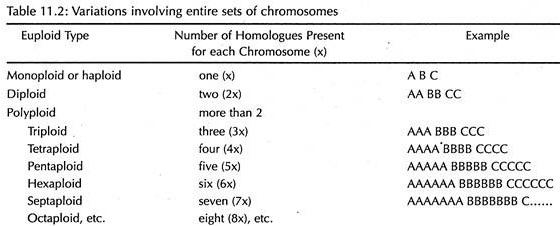In this article we will discuss about the Meaning and Types of Euploidy.
Meaning of Euploidy:
Euploldy is the presence of chromosome number which is the multiple of the basic chromosome set. An organism with the basic chromosome number 7, may have euploids with chromosome number 7, 14, 21, 28, 35, 42. Euploids are further of different types – monoploids, diploids and polyploids.
In monoploids there is a single set of genome, in diploids there are two sets of genome and in polyploids there are more than two sets of genome (Table 11.2).
Symbols of chromosome number:
2n = Somatic chromosome number of a diploid or polyploid species.
n = Gametic chromosome number of a diploid or polyploid species.
X = Basic chromosome number or genomic number.
In a diploid species with chromosome number 2n = 14, n = 7 as well as x = 7.
But in a polyploid (hexaploid) species with chromosome number 2n = 6x = 42, n = 21 but X = 7.
Types of Euploidy:
Monoploidy and Haploidy:
Monoploid individuals have single basic set of chromosome, e.g., in barley 2n = x = 7 (haploid of a diploid species). Haploids are individuals with chromosome number half of the somatic number, e.g., in wheat (2n = 3x = 21).
In diploid species, the chromosome number of monoploids and haploids are same, but in polyploid species the chromosome number of monoploids and haploids are different. In polyploid wheat (6x = 42), the haploid is 3x = 21 and manoploid is x = 7.
In flowering plants, the diplophase or the sporophytic phase dominates; the haplophase or gametophytic phase is normally limited to the pollen grains and the embryo sacs. In exceptional cases, plants may arise that are entirely haploid. With regard to all their parts, the haploids are smaller and often display poor vigour.
Meiosis:
Meiosis in a true haploid is of course very irregular and the chromosomes are distributed at random, some of them move to one pole, others to the opposite pole. Moreover, there is often chromosome elimination; i.e., single chromosomes are eliminated in the cytoplasm and are not included in the pollen grains or embryo sacs.
In most cases, pollen grains and embryo sacs will receive an incomplete or unbalanced chromosome constitution, which will have a lethal effect. Thus, the haploids are completely or almost completely sterile.
Types:
Haploids are of different types (Fig. 11.6). Polyhaploids are haploids obtained from polyploid species, for instance, wheat group, which is hexaploid with 2n = 42, contains more than one genome. If the genomes are homologous or partially homologous, bivalent formation and good fertility in the polyhaploid may be the consequence.
Aneuhaploids are also available and of two types — disomic haploid (haploid obtained from a tetrasomic) and nullisomic haploid (deficient of one chromosome than euhaploid).
Origin:
Haploids may originate spontaneously but, as a rule, in only very low frequencies. The haploids may be induced through
(i) Delayed pollination and the egg dividing without fertilization,
(ii) X-raying of pollen, and
(iii) Pollinating with an incompatible species, for instance, Solanum nigrum is pollinated with pollen from S. luteum, haploids of S. nigrum may arise. These haploids are derived from unfertilized egg ceils of S. nigrum.
A fourth method to obtain haploids and polyembryony is by the twin method. Lastly, the most important method for induction of haploidy is by culturing pollen grain in vitro as done in case of species of Datura, Oryza and some other agricultural crops.


